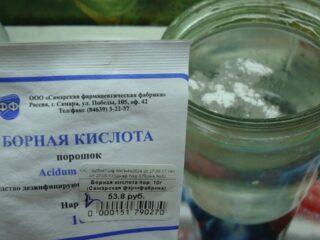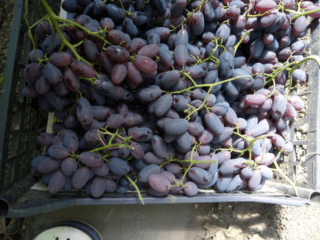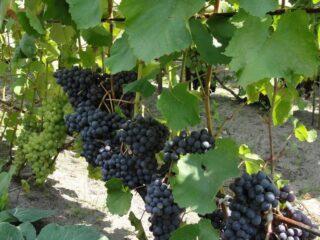Content
Bordeaux mixture for grapes is one of the universal and effective remedies against numerous harmful bacteria. This liquid has become widespread around the world due to its properties.
Why treat grapes with Bordeaux mixture?
To understand why a crop should be treated with liquid, you should study its mechanism of action. Bordeaux mixture, falling on grape leaves or vines, penetrates the juices of the plant. Microorganisms that feed on the culture receive a dose of poison, from which they die.

Pests treated with Bordeaux mixture die, other insects try not to get close to the sprayed bush
Composition of Bordeaux mixture for grapes
The main components of the drug are copper compounds, which are slightly soluble in water and thereby provide long-term protection to the plant.Bordeaux mixture for grapes contains copper sulfate and milk of lime. When diluted, depending on the proportions, the substance looks like a suspension of sky-blue color of varying intensity.
The chemical composition of the liquid will vary depending on the ratio of the components. If copper sulfate and calcium hydroxide are mixed in proportions of 2:1, then the result is predominantly CuSO4 compounds. But if you gradually increase the amount of lime in the mixture, copper oxide hydrate will form, which will affect the fungicidal effects of the substance.
If there is not enough Ca(OH) in the Bordeaux mixture, then an excess of copper sulfate will form, which will burn the leaf blades of the plant. The protective properties of this composition are low.

Maximum efficiency for a substance where copper sulfate and lime are combined in a ratio of 1:0.75
Pros and cons of the product
Any treatment of grapes with chemicals in the fall has both advantages and disadvantages. When purchasing a Bordeaux mixture, you should adequately evaluate its properties and application features.
Advantages:
- the product, distributed over the surface of the plant, remains there for up to a month, performing protective functions;
- wide spectrum of action;
- positive results of use can be noticed in a short time;
- the liquid does not damage the plant when used correctly;
- the substance is resistant to precipitation;
- economical consumption and ease of preparation.
Flaws:
- The diluted product has a shelf life of no more than a day;
- The greatest efficiency is only with freshly prepared Bordeaux mixture;
- the use of the drug requires compliance with the proportions and production instructions;
- improper use of the solution can destroy the grapes;
- moderate toxicity to humans and animals;
- When carrying out work, protective equipment must not be neglected.
How to dilute Bordeaux mixture for grapes
Unlike most drugs, the drug can be used in various concentrations. For grapes, Bordeaux mixture can be diluted as a 1% or 3% substance.
1% solution
The first stage of preparation is to select containers: you need to find two clean buckets with a volume of 10 liters each. Both plastic and enamel dishes are suitable.
Cooking algorithm:
- Dilute 100 mg of copper sulfate in 1 liter of warm water, heated to 30-50 °C. The contents in the bucket must be thoroughly dissolved so that no crystals remain.
- In a second bucket, mix 200 g of slaked lime with 5 liters of water. As the dry matter dissolves, the liquid gradually becomes the color of milk of lime. As a result, there should be no lumps left in it.
- Strain the contents of each container separately using burlap or gauze. In a bucket with copper sulfate, the volume of water must be increased to 5 liters.
- Mix the contents of the containers. The result should be a Bordeaux mixture of a pleasant sky-blue hue.

It is necessary to pour a copper solution into diluted lime, and not vice versa, since the latter provides protection to the leaves from burns
The result should be a solution with an acidic or slightly alkaline environment. If the gardener doubts his actions, it is recommended to check the concentration of the liquid. If there is excess acidity, the grapes will slow down their growth.If you spray the leaves with a strong alkaline agent, the effect of such treatment will be short-lived.

When mixing a solution of copper sulfate and lime, safety precautions should be observed.
To check the acidity level, simply dip litmus paper into the Bordeaux mixture. Its color should be blue, not red. Another popular method is common among folk methods: it is recommended to immerse a nail or wire in the substance for 1.5 minutes. If they change color to red, the acid level is too high.
3% solution
The operating algorithm is similar, but there are differences in the number of consumables. To obtain a 3% solution, you must use 300 g of copper sulfate and lime. Add 5 liters of water to each container with the substance and mix thoroughly.
When and how to spray grapes with Bordeaux mixture
Aimless and untimely use of the mixture can negatively affect both the growth and development of grapes and the level of their fruiting. For maximum effect, certain rules should be followed.
Treatment of grapes with Bordeaux mixture in spring and summer
The first spraying should be carried out in the spring even before the buds open. This stage of care will maximize the protection of the plant from microbes and pests.
Prepare a 3% solution for the procedure and pour it into a sprayer. Subject to safety precautions, treat the grapes before flowering.Bordeaux mixture should be applied evenly and generously so that it gets into all the cracks and crevices where harmful microorganisms like to settle.

After spraying with the mixture, a bluish coating may remain on the leaves.
The protective effect lasts for a month, so the treatment should be repeated in summer. The procedure must be carried out using a 1% liquid solution.
Treatment of grapes with Bordeaux mixture in autumn
Most gardeners leave the plant to prepare for winter after harvesting. But an equally important stage of care is the autumn processing of grapes. First you need to trim the bush, and then spray it with a 3% solution.
Safety regulations
Like any chemical, Bordeaux mixture can be dangerous to the human body. It doesn’t matter whether the gardener prepares the mixture or sprays the grapes in the spring before flowering, or in late autumn, he must adhere to the rules:
- Mandatory equipment includes rubber gloves, a mask and goggles.
- Clothing should be worn with long sleeves.
- While working, do not rub your eyes or touch your face.
- Spray quickly, in dry, windless weather.
- The presence of other persons during the procedure without protection is unacceptable.
- The prepared solution must be stored in a closed container, out of reach of children.
- If the substance gets on the skin or mucous membranes, quickly treat the affected parts of the body using running water. It is recommended to consult a doctor.
Common mistakes
Despite the instructions, gardeners may make the following mistakes when using Bordeaux mixture to process grapes:
- It is best to use a sprayer to irrigate the vines. Thanks to it, you can treat hard-to-reach places. Using a broom or brush will result in excessive fluid consumption.
- It is necessary to adhere to the work schedule so as not to harm the plant. Violation of the deadlines leads to the fall of the ovaries and damage to the grape clusters.
- It is recommended to carry out all work early in the morning or before sunset. The weather should be dry and warm. Neglecting these rules may result in leaf burns and decreased effectiveness of treatment.
- All work must be completed a month before harvest. All bunches of grapes must be washed under running water.
Sometimes gardeners note that the solution has separated. This reaction is the result of diluting a ready-made Bordeaux mixture. In this case, you cannot spray the grapes; the mixture should be prepared again, following the instructions.
If a gardener notices that the bush has slowed down its growth and few ovaries have formed, then there is a high risk of using the mixture incorrectly. This situation develops if the grapes are sprayed with a 3% solution at the beginning of the growing season. The maximum permissible concentration for spring treatment is 0.7-1%.
Conclusion
Bordeaux mixture for grapes is an effective, affordable product with a wide spectrum of action.To obtain the maximum effect, you must strictly follow the instructions and carry out the treatment several times a season. An important stage of the procedure is compliance with safety precautions and taking into account possible errors during the procedure.








